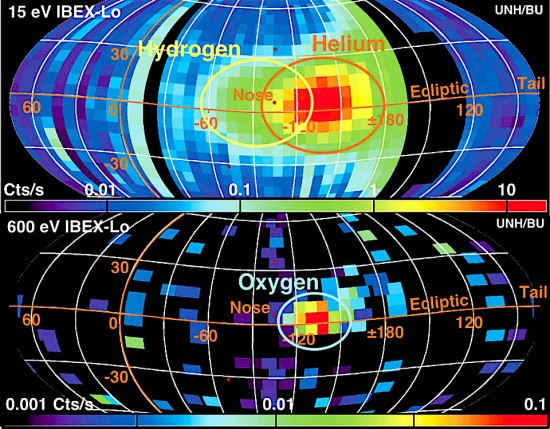
First observation of interstellar neutral Hydrogen and Oxygen. Credit: University of New Hampshire/Boston University.
Oct 06, 2016
The Interstellar Medium was detected by Voyager 1.
Electric Sun theory presupposes that the Sun is a positive terminal, or anode, in a complex interstellar circuit. The Sun’s negative pole, or cathode, is known as the heliosphere, a shell of charged particles surrounding the Sun’s electric discharge billions of kilometers away. Double layers at the heliosphere’s edge isolate the Sun’s plasma from galactic plasma. Galactic plasma is also called the Interstellar Medium (ISM).
Since Electric Universe theory assumes that all celestial bodies are connected by plasma filaments in vast circuits, the Sun must also be part of those circuits. The Sun is not an electrically stable object, however. Electric charge moves in and out of the Sun, sometimes increasing to the point where plasma discharges occur. Those tremendous lightning bolts are what heliophysicists call solar flares and coronal mass ejections (CMEs), although they would not think in terms of lightning.
A dark mode electric discharge radiates from the Sun in all directions. The “solar wind” travels outward to the edge of the Solar System at 700 kilometers per second, where it encounters the heliopause. Heat and pressure cannot explain how charged particles are accelerated as they pass by the planets on their way to the heliospheric cathode. No solar physicists expected such acceleration until it was discovered.
In an Electric Universe an obvious explanation exists for that acceleration: electric fields. Since electric charges travel through the Solar System in filamentary plasma tubes, then the Sun’s dark mode plasma can be affected by its electromagnetic fields. The easiest way to accelerate charge particles is in an electric field.
Voyager 1 is now in a part of space that exists between the Solar System and the ISM. Called a “cosmic purgatory” by the Voyager science team, it is where the solar wind from the Sun declines, and where high velocity protons “leak” into the ISM.
Wal Thornhill wrote that the most interesting effects outside the solar plasma sheath will be a powerful electric field accelerating those solar wind protons away from the Sun at cosmic ray energies equalling 10 billion electron volts. Electric Universe theory proposes that all stars generate cosmic rays in that way.
Between stars, in the so-called “vacuum of space,” there is still one atom per cubic centimeter. The ISM consists of gas and dust composed of hydrogen and helium, with a mix of dust grains less than .01 microns in size. Where the dust came from is not known, but astrophysicists think that it was ejected from stars. Some stars are observed with clouds of dust surrounding them. Deep space images reveal “lanes” of dust thousands of light-years in circumference looping around many galaxies.
The ISM contains ionized particles, as well as neutral molecules. Those electrons and positive ions are critical to understanding how the Solar System interacts with the ISM. Although it is extremely diffuse, charge separation can take place in different regions, so a weak electric field can develop. An electric field, no matter how weak, will initiate an electric current.
Electric currents generate magnetic fields. Voyager’s research team found magnetic fields strong enough to hold the boundary of the heliosphere together. Electric charge must be flowing through the ISM in order to create those fields.
Stephen Smith












